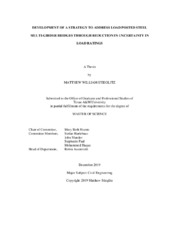| dc.contributor.advisor | Hueste, Mary Beth | |
| dc.creator | Stieglitz, Matthew William | |
| dc.date.accessioned | 2020-09-11T16:23:35Z | |
| dc.date.available | 2021-12-01T08:44:04Z | |
| dc.date.created | 2019-12 | |
| dc.date.issued | 2019-09-26 | |
| dc.date.submitted | December 2019 | |
| dc.identifier.uri | https://hdl.handle.net/1969.1/189197 | |
| dc.description.abstract | Bridges that are posted for load can cause a variety of issues for the people that use them and the entities that manage them. If a truck carrying goods must detour its route because it is too heavy to travel over a posted bridge, this increases its travel time and distance, and therefore costs. Load posted bridges also create issues for the state department of transportation (DOT) officials. Load posted bridges are a part of the inventory that must be more closely monitored and may require more work when conducting inspections or other maintenance. For these reasons, it is desirable for states to have as few load posted bridges in their inventory as possible. This research focuses on steel multi-girder bridges in the state of Texas. Current AASHTO codes and manuals provide procedures that can be used to estimate a bridge’s behavior. However, the specifications use simplified methods that provide a conservative analysis that may not represent the true behavior of the bridge.
The objective of this research is to explore the potential to improve the load rating of steel multi-girder bridges through three methods; the development of finite element models, the use of partial composite action in the analysis of a non-composite structure, and the use of refined live load distribution factors. This is done through the use of finite element models to more accurately model bridge behavior and through field load testing of a selected bridge to better understand its in-situ behavior. The results of the load test are analyzed through the three previously mentioned methods to observe where improvements in the bridge’s load rating could be made. The results of the load test are also used to calibrate the finite element model of the bridge to determine a maximum capacity that the bridge could carry. It was found that the specific bridges tested were able to carry a capacity greater than that of which they are posted, and that the postings are likely not necessary on the bridges. | en |
| dc.format.mimetype | application/pdf | |
| dc.language.iso | en | |
| dc.subject | load rating | en |
| dc.subject | bridge | en |
| dc.title | Development of a Strategy to Address Load Posted Steel Multi-Girder Bridges Through Reduction in Uncertainty in Load Ratings | en |
| dc.type | Thesis | en |
| thesis.degree.department | Civil and Environmental Engineering | en |
| thesis.degree.discipline | Civil Engineering | en |
| thesis.degree.grantor | Texas A&M University | en |
| thesis.degree.name | Master of Science | en |
| thesis.degree.level | Masters | en |
| dc.contributor.committeeMember | Hurlebaus, Stefan | |
| dc.contributor.committeeMember | Mander, John | |
| dc.contributor.committeeMember | Paal, Stephanie | |
| dc.contributor.committeeMember | Haque, Mohammed | |
| dc.type.material | text | en |
| dc.date.updated | 2020-09-11T16:23:36Z | |
| local.embargo.terms | 2021-12-01 | |
| local.etdauthor.orcid | 0000-0001-8315-8871 | |


